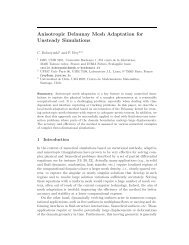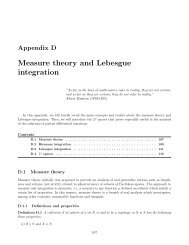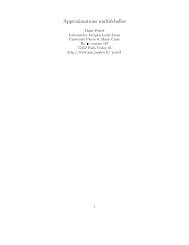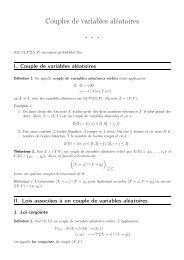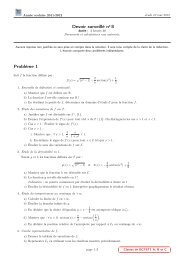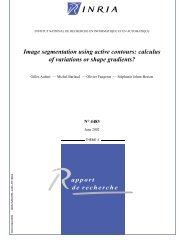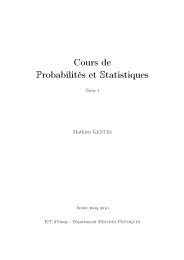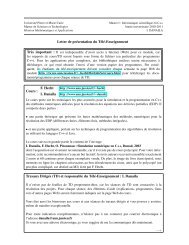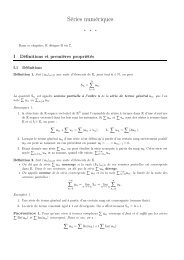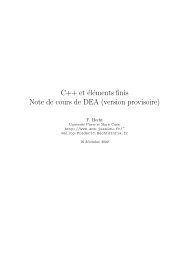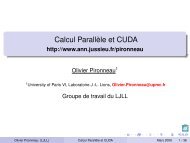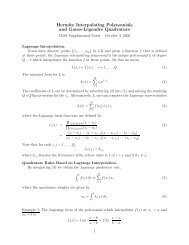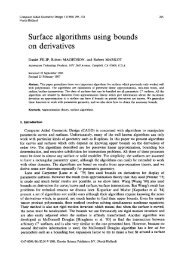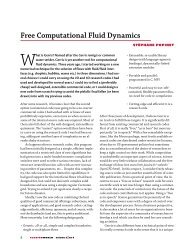pdf file
pdf file
pdf file
Create successful ePaper yourself
Turn your PDF publications into a flip-book with our unique Google optimized e-Paper software.
BOGOLIUBOV SPECTRUM OF INTERACTING BOSE GASES 33<br />
Now we turn to a localization for � HN := UN(HN −NeH)U ∗ N .<br />
Lemma 24 (Localization for � HN). For every 1 ≤ M ≤ N we have<br />
− C<br />
M2 �<br />
CdΓ(h) ≤N +C −λ1(<br />
|F+ � �<br />
HN) ≤ � HN −fM � HNfM −gM � HNgM ≤<br />
≤ C<br />
M2 �<br />
CdΓ(h) ≤N +C −λ1( |F+ � �<br />
HN) .<br />
Proof. We apply Proposition 22 with A = � HN −λ1( � HN) and σ = 2. From<br />
the inequality � HN ≤ C(H + C) due to Proposition 15, we see that the<br />
+C. �<br />
diagonal part of � HN can be bounded from above by CdΓ(h) |F ≤N<br />
+<br />
Remark 9. The error term dΓ(h) |F ≤N<br />
+<br />
in Lemma 24 can be further replaced<br />
by C(H+C) due to (16), or replaced by C( � HN +CN) due to the stability<br />
HN ≥ (1−α1)<br />
N�<br />
i=1<br />
Ti −CN ≥ 1−α1<br />
1+α2<br />
N�<br />
hi −CN on H N ,<br />
where α1 and α2 are given in Assumption (A1). The bound dΓ(h) ≤ C( � HN+<br />
CN) on F ≤N<br />
+ also implies that λ1( � HN) ≥ −CN, although it is not optimal<br />
(we shall see that λ1( � HN) is of order O(1)).<br />
i=1<br />
7. Proof of Main Theorems<br />
Werecall thatwehaveintroducedthenotation � HN := UN(HN−NeH)U ∗ N .<br />
7.1. Proof of Theorem 2. The first statement of Theorem 2 was already<br />
proved in Corollary 16 above. We now turn to the proof of the other statements,<br />
using the localization method.<br />
Step 1. Convergence of min-max values.<br />
Upper bound. By applying Lemma 23 and Proposition 15, we have, for every<br />
normalized vector Φ ∈ D(H) and for every 1 ≤ M ≤ N,<br />
H ≥ fMHfM +gMHgM − C<br />
M2(H+C) ⎡�<br />
� �−1 �<br />
⎤<br />
≥ fM ⎣<br />
M M<br />
1+C �HN −C ⎦fM<br />
N N<br />
+λ1(H)g 2 C<br />
M −<br />
M2(H+C). (55)<br />
Now fix an arbitrary L ∈ N. For every δ > 0 small, we can find an<br />
L-dimensional subspace Y ⊂ D(H) ⊂ F+ such that<br />
max<br />
Φ∈Y,||Φ||=1 〈H〉 Φ ≤ λL(H)+δ.<br />
By using the inequality g 2 M ≤ 2N+/M and N+ ≤ C(H+C), which is due to<br />
(16), we get ||gMΦ|| 2 ≤ CL/M for every normalized vector Φ ∈ Y. Here CL<br />
is a constant depending only on λL(H) − λ1(H). Therefore, if M > LCL,



